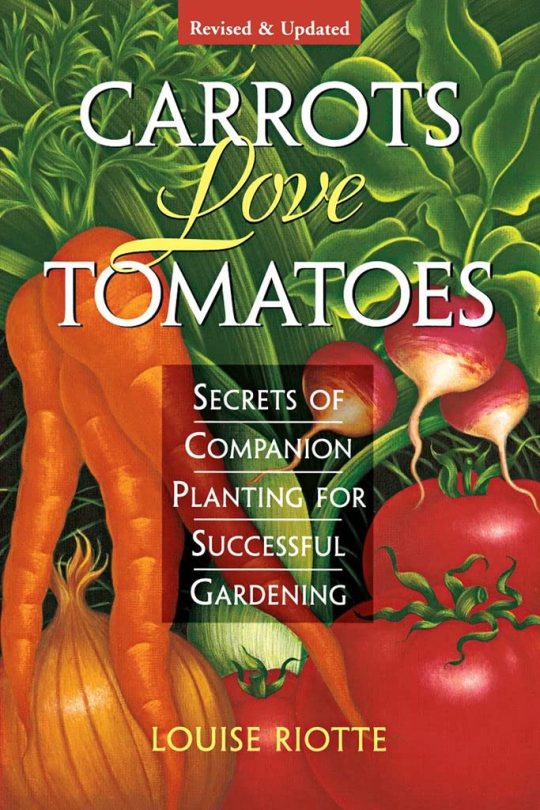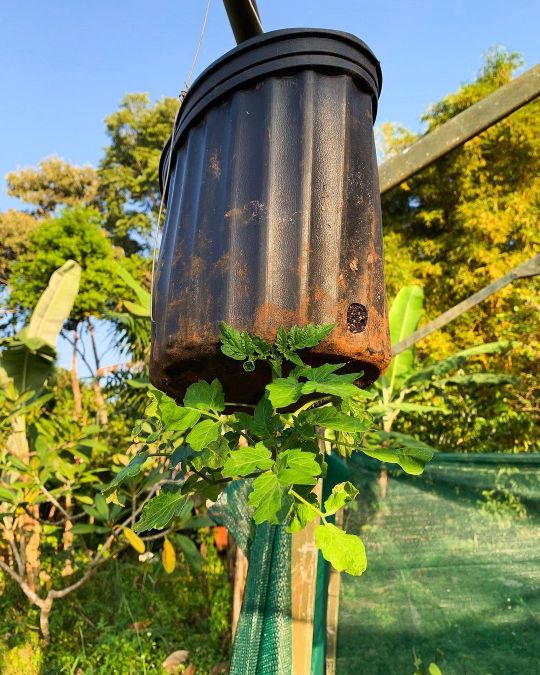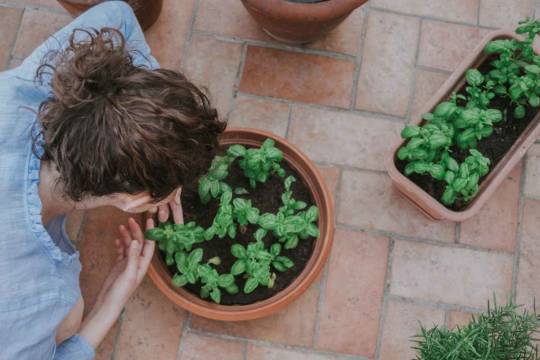#companionplant
Photo

Just Some Weeds…
Found growing in a pot left out over winter. A native, wild violet and moss. Repotted to accompany trees also living in pots.
#kusamono#companionplant#bonsai#penjing#penzai#bonsaipenjing#scottrodell#scottmrodell#swordsmanbonsai
8 notes
·
View notes
Text

This gardening classic was first published in 1975, and now a second generation of gardeners who prefer pest-resistant planning to chemicals will find a place for it on the shelves. Not only does it tell what to plant with what, but also how to use herbal sprays to control insects, what wild plants to encourage in the garden, how to grow fruit and nut trees, how to start small plots or window-box gardens, and much more. It's one of the most practical books around for any gardener of edibles, no matter how serious or casual!
#companionplanting#organicgardening#organicgarden#organicgrowing#organicgrowth#organicgardener#gardening#lovegardening#gardeningbooks#garden#gardening tips#gyo#gardening uk#gardenchat#organic gardening#vegetable gardening#backyard#gardeners on tumblr#gardenblr#gardencore
133 notes
·
View notes
Photo

Did you know that hanging tomato plants upside down not only frees up more ground space but also avoids most pest like snails and slugs. A companion plant can also be planted topside to maximize space and benefits. Hanging upside down also bemeans there's no need for staking and good air flow means that soil borne diseases are also reduced. . . Èske w te konnen ke Lè’w pandye plant tomat yo tèt anba non sèlman libere plis espas, men tou evite pifò ensèk nuizib tankou kalmason. Yon plant konpayon kapab tou plante avè’l pou maksimize espas ak benefis yo. Pann tèt anba vle di tou pa gen okenn nesesite pou jalonj ak bon sikilasyon lè vle di ke maladi tè yo tou redwi. . . #growninhaiti #tomatoes #tomato #upsidedownplanter #haiti #ayiti #companionplanting #regenerativefoodsystems #foodsecurity https://www.instagram.com/p/CmMMl0GuV6k/?igshid=NGJjMDIxMWI=
#growninhaiti#tomatoes#tomato#upsidedownplanter#haiti#ayiti#companionplanting#regenerativefoodsystems#foodsecurity
24 notes
·
View notes
Text
Companion planting with lettuce: What to plant next to lettuce
Hey fellow gardeners! 🌱🌼 Today, I'm excited to share my latest article on Companion Planting with Lettuce!
Discover the best companions to grow alongside your lettuce, including beets, carrots, and parsnips! 🥕🥬🍓
Improve the health and productivity of your garden with organic gardening methods. 🌿 Ready to learn more?
Click the link below to read the full article on Click to Grow.
Happy gardening!
🌻🌿 #organicgardening #companionplanting #lettuce #healthygarden #ClickToGrow"
Read the full article
2 notes
·
View notes
Link
Best (and worst) companion plants for growing peppers.
My favs:
1. Sweet Alyssum: Underplant your pepper plants with a carpet of sweet alyssum. In addition to enhancing biological control, it’s also beautiful. The small blooms of this low-growing annual plant feed a whole host of good bugs that help a gardener manage pepper pests. Parasitic wasps, syrphid flies, tachinid flies, ladybugs, and lacewings are all found sipping from the blooms. And when they’re not drinking nectar, some of these beneficial insects are eating pests like aphids, whiteflies, and thrips, while others are laying their eggs in pests like hornworms, bud worms, and fruit worms.
2. Onions/garlic/chives: Green peach aphids are among the most common pests of peppers. Interplanting peppers with members of the allium family, including chives, onions, garlic, and scallions, has been shown to deter these small insects from settling on pepper plants to feed. Plant the allium crops around and in between your pepper plants. Or plant your peppers smack in the middle of your onion crop.
3. Nasturtiums: if aphids plague your pepper plants, consider planting a nearby companion planting of nasturtiums. A favorite of aphids, the lovely round leaves of nasturtiums are much preferred by this pest. The aphids opt to feed on the nasturtiums and leave your peppers alone. Since aphids are tiny and can’t travel very far, you’ll want these two plant partners located within a foot or two of each other.
#companion plants#companionplants#companion planting#peppers#growing peppers#hot peppers#garden witch#homesteading#grow your food#grow your own food#nasturtiums#sweet alyssum
2 notes
·
View notes
Text
☘️"Maximizing Garden Space: Organizing Plants for Optimal Growth and Yield"🌱
🌱🌿 Maximize your garden space with these tips for optimal plant organization! Grow more, harvest more, enjoy more!
#GardenOrganization#MaximizeSpace#GrowMorePlants#GardeningTips#VerticalGardening#CompanionPlanting#RaisedBeds#IntensivePlanting#SuccessionPlanting
0 notes
Text
15 Must Have Companion Plants for Edible Gardening
Companion Planting
Blossom Bliss Gardening
Welcome back to the vibrant world of edible gardening! Today, we embark on a journey into the art of companion planting, a gardening technique that goes beyond the ordinary. As we delve into the intricacies of this green alliance, we’ll uncover why companion planting is more than just a horticultural strategy; it’s a symphony of nature’s own design…

View On WordPress
#CompanionPlanting#EdibleGardening#GardenCompanions#GardenEcosystem#GardenHarmony#GreenThumb#GrowTogether#HealthyCrops#NaturalPestControl#PollinatorFriendly
0 notes
Link
🌱 Striped flea beetles can be a real nuisance for gardeners. These small, black and yellow beetles can quickly destroy plants by feeding on their leaves, leaving behind unsightly holes and damage. If you're struggling with these pests in your garden, don't worry – there are ways to manage them and protect your plants. 🌿 One of the most effective ways to manage striped flea beetles is to use physical barriers. This can include things like row covers or netting, which can prevent the beetles from accessing your plants in the first place. You can also try using sticky traps or even handpicking the beetles off your plants, although this can be time-consuming. 🍅 Another option for managing striped flea beetles is to use natural or chemical insecticides. Neem oil, for example, is a natural insecticide that can be effective against these pests. Chemical insecticides can also be effective, but it's important to choose a product that's safe for your plants and the environment. With the right approach, you can keep striped flea beetles under control and enjoy a healthy, thriving garden.1. Understanding the Life Cycle of Striped Flea BeetlesStriped flea beetles are small, black insects with yellow stripes that feed on plants. Understanding their life cycle is crucial in controlling their population. Adult beetles emerge from the soil in late spring and early summer. They feed on leaves and lay eggs in the soil near the plants they feed on. Eggs hatch into larvae that feed on plant roots. Larvae pupate in the soil and emerge as adults in late summer. Adult beetles overwinter in the soil and emerge in the spring to start the cycle again. They can have up to three generations per year. Controlling striped flea beetles can be done through crop rotation, using row covers, and applying insecticides. Early detection is key to preventing damage to plants. can help gardeners and farmers prevent damage to their crops and plants. 🌱🐞2. Identifying Signs of Striped Flea Beetle Infestation in Your Garden🔎 Signs of Striped Flea Beetle Infestation: Small holes in leaves Shiny, metallic beetles on plants Yellowing or wilting leaves Stunted plant growth 🔍 Check for beetles early in the season, as they can cause significant damage in a short time. 🔍 Inspect the undersides of leaves, as this is where the beetles lay their eggs. 🔍 Use row covers to prevent adult beetles from laying eggs on plants. 🔍 Rotate crops to prevent beetles from building up in the soil. 🔍 Use insecticidal soap or neem oil to control infestations. 🔍 Keep plants healthy and well-watered to help them resist beetle damage.3. Natural Ways to Control Striped Flea Beetles in Your GardenStriped flea beetles can be a nuisance in your garden, but there are natural ways to control them without using harmful chemicals. Plant garlic, onions, and chives to repel flea beetles. Use row covers to prevent adult beetles from laying eggs on plants. Introduce beneficial insects like ladybugs and lacewings to eat flea beetle larvae. Another effective natural method is to use neem oil, which disrupts the beetles' feeding and mating habits. Mix neem oil with water and spray on affected plants. Apply diatomaceous earth around plants to dehydrate and kill flea beetles. Use a sticky trap to catch adult beetles. Regularly inspect your plants for signs of flea beetle damage, such as small holes on leaves, and take action immediately to prevent further infestation. By using these natural methods, you can control striped flea beetles in your garden without harming the environment or your health. 🌿🐜🌼4. Chemical Control Options for Striped Flea Beetles in Your GardenChemical control options can be effective against striped flea beetles in your garden. Here are some options to consider: Insecticidal soap: A low-toxicity option that works by suffocating the beetles. Apply to both sides of leaves. Pyrethrin: A natural insecticide derived from chrysanthemums. Can be used as a spray or dust. Neem oil: An organic option that disrupts the beetles' hormones and feeding. Apply to both sides of leaves. It's important to read and follow all label instructions when using chemical control options. Rotate between different options to prevent resistance. Always use protective gear when applying chemicals and avoid spraying during windy conditions to prevent drift. 🌬️ Consider using integrated pest management techniques to reduce the need for chemical control. This can include crop rotation, companion planting, and using row covers. 🌱 Remember, chemical control should be a last resort after trying other methods. 🚫🐛5. Preventing Future Infestations of Striped Flea Beetles in Your GardenPrevent future infestations of striped flea beetles by: Rotating crops to avoid planting the same family of plants in the same spot each year. Covering seedlings with floating row covers to prevent beetles from laying eggs. Using sticky traps to catch adult beetles before they can lay eggs. Applying neem oil or insecticidal soap to plants to deter beetles. Maintaining healthy soil with compost and proper watering to help plants resist infestations. Regularly inspect plants for signs of infestation, such as small holes in leaves and yellowing foliage. Remove any affected plants immediately to prevent the spread of beetles. Encourage natural predators, such as ladybugs and lacewings, by planting flowers that attract them. Consider companion planting with plants that repel beetles, such as garlic and onions. By taking preventive measures, you can enjoy a healthy and thriving garden free from striped flea beetle infestations. 🌱🐞6. Best Practices for Managing Striped Flea Beetles in Your GardenStriped flea beetles are a common pest in gardens. Here are some best practices to manage them: Rotate crops to prevent infestations Use row covers to protect plants Remove weeds and debris to eliminate hiding places Apply organic insecticides like neem oil or pyrethrin Regularly inspect plants for signs of damage and adult beetles. Handpick and dispose of them. Encourage natural predators like birds and spiders. Plant companion crops like marigolds and basil to repel beetles Water plants deeply to promote healthy growth and resilience Avoid over-fertilizing, which attracts beetles Consider using sticky traps to catch beetles Remember, prevention is key. Monitor your garden regularly and take action at the first sign of infestation. Happy gardening! 🌱🐞 In conclusion, managing striped flea beetles in your garden is crucial to ensure a healthy crop. Regular inspection, crop rotation, and the use of organic insecticides can help control their population. Remember to keep your garden clean and healthy to prevent infestations. Don't let these pesky beetles ruin your hard work. Take action early and follow these tips to keep your garden thriving. 🌱🐞👨🌾 With proper management, you can enjoy a bountiful harvest and a beautiful garden all season long. Happy gardening! 🌻🍅🥦 https://fleatreatment.uk/managing-striped-flea-beetles-in-your-garden/?_unique_id=647d32708e224
#Uncategorised#companionplanting#gardenpestcontrol#naturalinsecticides#organicgardening#stripedfleabeetles#aiomatic_0
0 notes
Link
#airtightcontainers#anticoagulantmedications#astilbes#bees#BerlinerWeisse#borderfronts#butterflies#coffee#companionplanting#contraindications#culinaryarts#deer-resistant#dessertrecipes#dryingleaves#Europe#Europeanfolklore#ferns#groundcover#harvesting#headaches#henna#herbaceousperennial#hostas#icedtea#intestinaldiscomfort#kidneystones#lactation#liverdisease#madderfamily#Maibowle
0 notes
Text
Basil Companion Plants: The Ultimate Beginner’s Guide

Basil Companion Plants
When certain plants are grown together, they can enhance each other’s growth and flavor while also deterring pests and improving the soil. One of the best herbs to experiment with is basil, which not only smells and tastes great but can also add vibrant color to your garden.
#garden#gardening#gardenlife#gardenliving#gardenlove#homegarden#backyardgarden#growyourownfood#growyourown#growyourownveggies#growyourownvegetables#vegetablegarden#vegetablegardening#vegetablegardens#basil#basilplant#basilplants#companionplanting#companionplants#growingfood#growingfromseed#gardeninglife#backyard garden#gardening tips#vegetable garden#planting
1 note
·
View note
Text

Enter the world of companion planting, where gardening involves plants working together to promote growth and deter pests. Among these cooperative allies, chamomile stands out as a gentle yet strong leader, blending in with other garden companions. Join us in exploring the enchanting world of companion planting and learning how chamomile flourishes alongside fellow plants, creating a thriving oasis of beauty and abundance. Dive into the world of harmonious gardening and uncover the symbiotic relationships that bring chamomile's garden to life!
Companion Planting: Chamomile's Garden Allies
#gardening#lovegardening#gardening uk#gardening tips#garden#gyo#gardenchat#organic gardening#vegetable gardening#backyard#chamomile#companionplanting#gardeningtips#gardeningtip#gardeningtipsforbeginners#organicgarden#OrganicGardening#organicgrowth#plants#gardens#home and garden#container garden#botanical garden#flower garden#gardenblr#gardencore#gardeners on tumblr#my garden#potted garden#urban gardening
16 notes
·
View notes
Photo

Who would have thought that hot peppers grow well with pink bananas? When you think about it, the world is a pretty amazing place. We have plants that can grow through snow and ice, flowers that bloom in the desert and produce fruit all year long, and even trees that can survive being planted upside down. But what about the relationship between plants? What about the hidden bonds that exist between plants and other organisms? And how do those relationships affect our health? To answer these questions, we need to look beyond just what grows well together in a regenerative food system. We need to look at everything—from soil to air to water—and start asking questions about what grows best together, and why. #growninhaiti #agrinatif #hotppeppers #pinkbananas #haiti #ayiti #regenerativefoodsystem #hayti #peperslovepinkbananas #organic #companionplanting #community #foodsecurity #nurtureyournature #agroforestry https://www.instagram.com/p/CghEdMIu141/?igshid=NGJjMDIxMWI=
#growninhaiti#agrinatif#hotppeppers#pinkbananas#haiti#ayiti#regenerativefoodsystem#hayti#peperslovepinkbananas#organic#companionplanting#community#foodsecurity#nurtureyournature#agroforestry
12 notes
·
View notes
Text
What Should Not Be Planted Near Cabbage?
Attention gardeners! 🌿
Did you know that there are certain plants that should not be planted near cabbage?
Avoiding these plants can help ensure the health and growth of your cabbage plants.
Check out my latest article on "Plants to Avoid Planting Near Cabbage" to learn more about which plants to steer clear of.
Your cabbage plants will thank you! 🥬
https://gardenguide4all.com/what-should-not-be-planted-near-cabbage/
Read the full article now at Click to Grow. #organicgardening #cabbage #gardeningtips #ClickToGrow #ChappyTheGardener
Read the full article
0 notes
Photo

Marigold 🌼🌼🌼 "It does not matter if you are a rose or a lotus or a Marigold. What matters is that you are flowering." #marigold #spring #flower #nature #companionplanting #permaculture https://www.instagram.com/p/CkSlgMjpIQG/?igshid=NGJjMDIxMWI=
0 notes